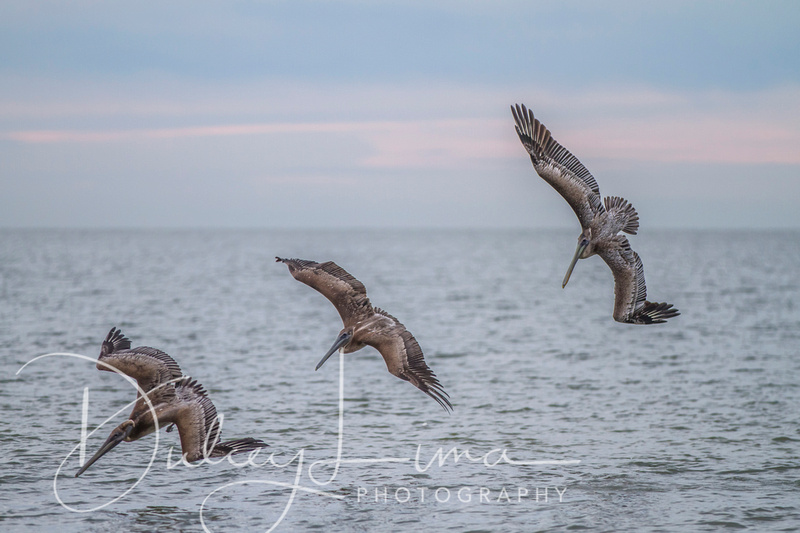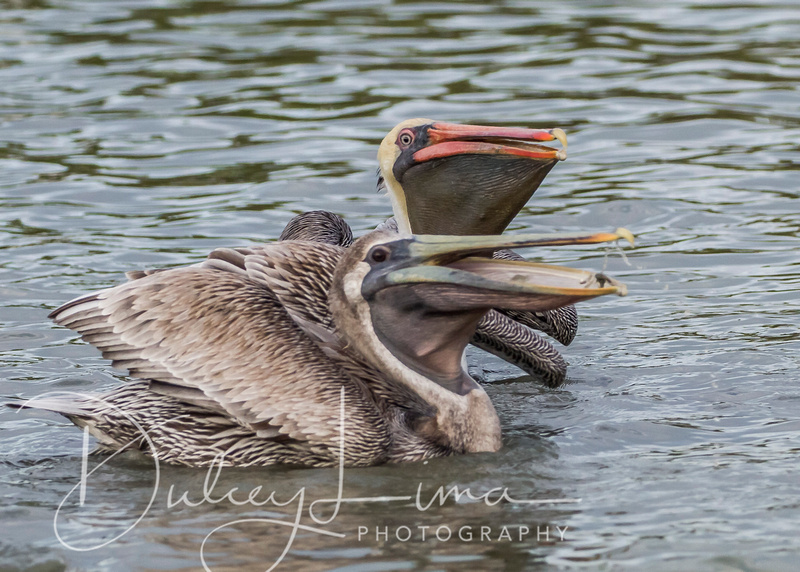Brown Pelicans Steal the ShowAbout 520 different birds call Florida home. Some are considered spectacular, and I acknowledge that Snowy Egrets, Wood Storks and Spoonbills are personal favorites. But the birds that really steal my heart are the Brown Pelicans.
The Brown Pelican, Pelicanus Occidentalis, is a large, coastal sea bird characterized by a large bill, thin neck, webbed feet and large (gular) pouch. Unlike all other pelicans, the Brown Pelican can plunge dive from 30 feet above the water, using the force of impact with the water to stun the fish. As it hits the water, the throat pouch expands to trap the fish, filling it up with about 2 ½ gallons of water. It then tips its head down to drain the water from its pouch, and tosses its head back to swallow the fish. This action is both dramatic and comical, which makes watching pelicans a favorite pass time of beachgoers. Brown Pelicans can spot a fish from as high as 65 feet, and they eat about 4 pounds of fish per day. They are gregarious birds and nest in colonies, usually in mangroves on isolated islands in South Florida or in small trees. They often fly and fish in a straight line or next to each other along the shore. During a dive, the Brown Pelican tucks its head, folds its wings back and rotates its body to the left as it enters the water. They may turn left to cushion their trachea and esophagus which are located on the right side of their bodies. Air sacs in the bones and under the skin make them buoyant, cushion the impact when plunging and help them rise quickly to the surface. Brown Pelicans are the smallest Pelicanus in the family, but they are still large birds, with bodies 40-54 inches long and a wingspan of 7-8 feet. Adults weigh about 8 pounds and have gray and brown wings, yellow heads and white necks and breasts. Their head feathers turn a russet color when breeding. Juvenile Brown Pelicans have grayish brown heads and bodies and are nearly the same size as the adults by the time they fledge from the nest at about 71-93 days. They reach full maturity at 3-5 years old. Female and male Pelicans have nearly the same markings with females being slightly smaller. Adult Brown Pelican eyes have a blue iris, which changes to brown during the breeding season.
In flight, Brown Pelicans flap their wings a few times-- then glide, surfing high and low on the updrafts along the waves. If the fish are plentiful in shallow or muddy water, they sometimes feed by sitting on the water’s surface, lurching forward to seize the prey with their bills. This is also the hunting strategy typical of all other types of pelicans. Brown Pelican populations are now very stable, thanks to decisions made through the Endangered Species Act and the Environmental Protection Agency. Pelicans were listed as endangered in 1970 due to exposure to DDT that was found to thin their eggs, resulting in reproductive failure. In 1972, the EPA banned DDT, and Brown Pelicans began to recover. In 2009, the Brown Pelican was delisted as an endangered species and their numbers have again returned to healthy levels. Birds of prey such as Bald Eagles or Hawks have been known to eat the eggs of Pelicans, and toxins in the water or in the fish the Pelicans eat can make them ill. Nest disruption by people can also have a negative impact on population numbers. Pelicans stand on their eggs to keep them warm, and when humans come too close to the nest or scare the parent bird away, the Pelican's feet can contract reflexively and crack the shell. Fishing line and hooks also pose threats to Pelicans because at times the Pelicans are going after the same fish as the fisherman, resulting in a Pelican swallowing a hook in the process. Brown Pelicans give photographers a fighting chance to capture a good picture because they can be seen from a distance, providing both time and opportunity to get the bird in focus. Their wings do not flutter quickly like those of tiny birds, and their distinctive features and behavior make practicing fun. They can look like prehistoric cartoons as they bank and suddenly hurl themselves down into the water. It is always a treat to see them throw their heads back to swallow their catch.
A 100-400 mm zoom lens is very helpful because Pelicans are large, powerful flyers and can get close so quickly, that it can be difficult to get the entire bird in the frame with a fixed lens. Experiment with different ISO settings, and don’t be afraid to try a higher ISO than you would ordinarily use so you can stop the action of the wings in flight. Most of my images of pelicans were taken with an F stop of 5.6 and an ISO of 640. Shooting around sunrise or sunset when the sun is lower on the horizon provides the best illumination, particularly if the Pelican is flying towards the sun. When flying away from the sun, the Pelican’s large wings often shade its eyes and head, causing a loss of detail.
Whether you photograph Brown Pelicans in the air or bobbing on a shallow pond, they are sure to provide plenty of opportunities for learning, laughing and capturing some memorable images. Sources: http://www.audubon.org/field-guide/bird/brown-pelican https://www.allaboutbirds.org/guide/Brown_Pelican/id https://nationalzoo.si.edu/animals/brown-pelican https://en.wikipedia.org/wiki/Brown_pelican Comments
Ann(non-registered)
This was an excellent article with the most beautiful photography! Loved the action shots and the clarity.
Learned a ton without having to read a whole book.
Terry Lee(non-registered)
The Brown Pelican is one of my favorites as well. Your photographs are excellent and I learned quite a bit from reading your Blog. It was especially interesting to learn why they dive favoring their left side.
Vida(non-registered)
Excellent images! Great information about these almost “ prehistoric “ looking birds! Happy shooting!
No comments posted.
Loading...
|








